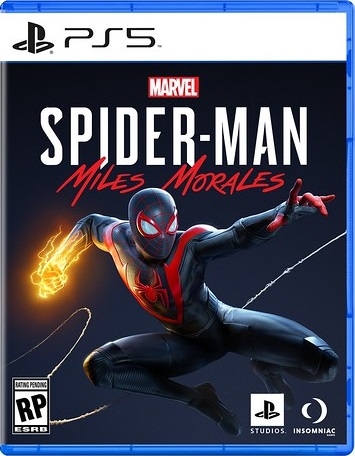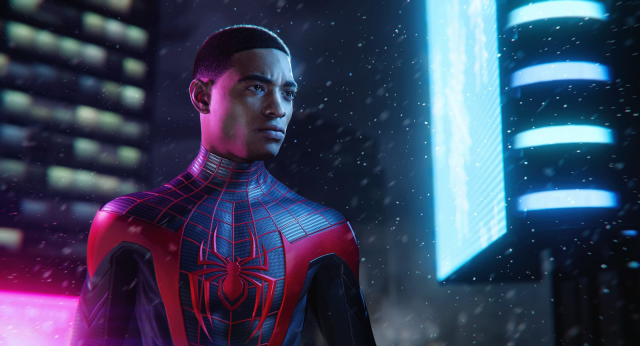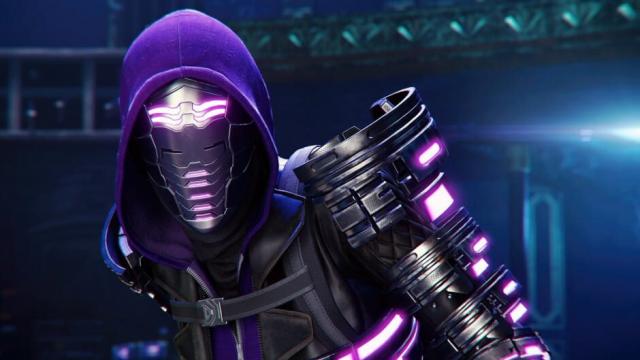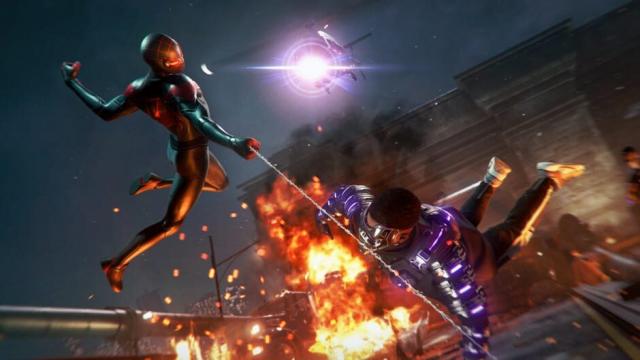Existing User Log In
New User Registration
Register for a free account to gain full access to the VGChartz Network and join our thriving community.





America - Front


America - Back

Insomniac Games
Action-Adventure
 11/12/20 Sony Interactive Entertainment
11/12/20 Sony Interactive Entertainment  (Add Date)
(Add Date) 11/12/20 Sony Interactive Entertainment
11/12/20 Sony Interactive Entertainment
| Owners: | 5 | |
| Favorite: | 0 | |
| Tracked: | 0 | |
| Wishlist: | 0 | |
| Now Playing: | 0 | |
[Reviewer's Note: Although I do my best to avoid SPOILERS, I will mention story details that I liked/disliked, albeit as vaguely as possible. Reader discretion advised.]
The overnight critical and commercial success of Marvel's Spider-Man (2018) showed how Insomniac Games took uncle Ben's greatest lesson to heart, surpassing all of Activision's previous tries in the past decade. With the later-released expansion packs and now this side story, there’s clearly no intention of slowing down. Spider-Man: Miles Morales lands in an advantageous spot too. By being both a cross-generation title launching on PS5 and a lower-priced 'sidequel,' akin to Uncharted: Lost Legacy, Insomniac gets to flex its technical knowhow whilst maintaining the realistic expectation of not having to reinvent the foundation. Despite several mechanical tweaks giving Miles an improved action vocabulary, a prosaic plot and some weak characters harm an otherwise engaging game.
A year after the events of Spider-Man, Miles' life has become quite hectic. He's been bitten by a radioactive spider, begun to grow under the tutelage of Peter Parker, and has moved from Brooklyn to his grandmother's apartment in Harlem. Still wrestling with these newfound responsibilities and his father's untimely death, more responsibility is thrust upon Miles after learning Peter's taking an overseas work vacation with Mary Jane. As a new threat emerges, known as “The Underground,” Miles swinging solo presents a decisive question: does he deserve to call himself Spider-Man?

Such emotionally earnest intentions course through this story across a couple of understated avenues. During both the discovery of Miles' exclusive Venom Abilities (bio-electricity) and his less-assured swinging animations at the beginning, it's easy to sympathize with his hesitation of assuming this mantle. It’s not just any role either; there's something about Spider-Man that New York has been comfortable with for nearly a decade. You'll notice in specific side stories or when Miles' buddy, Ganke, begins the Friendly Neighborhood Spider-Man app, that Harlem isn't quite sure of his aptitude either.
These palpable emotional stakes for Miles rarely translate into the phoned-in main storyline though. Early on, there's a decent rhythm of story and gameplay until a dramatic bridge sequence - probably my favorite part. After that, the narrative is set on a predictable path that relies on obvious contrivances to reach its climactic ending. One of the weakest qualities in this equation is the villains. Appropriating a B-lister from the Iron Man franchise, Simon Krieger could've been an interesting choice; unfortunately, the writers thought "smarmy Elon Musk plus fitness dudebro" was enough. Miles' central conflict comes from another less-popular source: The Tinkerer. She and her band of vicious cyberpunk-admiring minions only have unexpected aesthetics to boot. Despite attempting more of a nuanced conflict between Miles & The Tinkerer, the drama propelling the final act is forced and actually hypocritical on her part. The way it tries to squeeze emotion only makes the artifice more noticeable.

Beyond those stated annoyances, I didn't find Miles to be that compelling of a protagonist. This isn't to take away from Nadji Jeter's performance or his supporting cast. Aside from Troy Baker showing up for the day, everyone was more than serviceable at their given roles. My issues come down to some of his cringe-inducing dialogue and how closely he lands to the other Spider-Man in attitude. When you have someone who suggests their own rich potential I don't see how a lesser Peter Parker who's trilingual and a different ethnicity can maintain the same attention.
To elucidate my dilemma: the fan-expected "New York standing with Spider-Man" scene wouldn't have landed without the substantial side content. Side Missions in particular crystalize the little details that make Spidey so beloved for me. One mission involves a homeless center (F.E.A.S.T.) being hastily condemned, thus forcing workers & homeless alike to survive in the blistering cold. What begins as sewage issues blossoms into armed thugs, nefarious land acquisition plans, and corrupt government bureaucracy for Miles to discover and stop. The best part is seeing your success change this slice of Harlem. The makeshift tents and garbage can fires are replaced with F.E.A.S.T. North's lights coming back on and there's a lovely welcoming committee outside its doors. These are the type of examples that sustained my engagement between staid campaign revelations.
In sum, it's a bit frustrating to manage my appreciation for a lopsided effort. The insane predictability makes me suspicious that this main storyline was lifted from a discreet comic; conversely, the inspired touches in Miles' familial life and side missions showcase greater creative inspiration. It's like wading through muck to get heartfelt moments such as when Miles converses with his deaf love interest, Hailey, in sign language. If you venture hard enough you'll understand the earned reputation of Harlem's new Spider-Man; then again, it’s a shame you have to do that.

By sticking with a polished foundation, one doesn't need to try admiring Miles Morales' gameplay. For anyone who hasn't played Spider-Man, the core can be broken into two components: the open world traversal of nearly every Spiderman title mashed with Batman: Arkham's Freeflow combat system. It's another sub-genre that's become typical in the AAA industry, but it's so damn rewarding and fitting for this universe. Spidey Sense meshes perfectly as a warning indicator, his wall-crawling abilities enable more flexible stealth options than other copycats, and on and on it goes. The arguments made back in 2018 still hold up today; it’s an incredibly fitting system for this universe.
Miles further solidifies his utility with special abilities that are all his own. After a critical moment in the beginning, Miles unleashes his bioelectric-enabled super punch and its concurrent stunning properties. Along with that, there's a greater area-of-effect (AoE) emphasis when managing more enemies this time around. All of the previous moves, counters, and finishers are here as well. The gadgets are limited, yet purposeful in implementation in either combat or stealth.
One of my favorite additions is Miles' innate camouflage. Despite appreciating Spider-Man's flexibility compared to Batman's more scripted demands for gargoyles or specific perches, stealth wasn't often an option after being detected the first time; now, Miles could be against eight goons mid-fight, turn invisible, whisk himself to the rafters, and recalibrate his approach when they go back to an investigative state. Considering the copious enemies and expansive levels there's a greater necessity for it as well. The ebb-n-flow of this stealth-action foundation feels intuitive and dynamic past the rolled credits. The greater number of enemies complements this aspect and puts a heavier emphasis on stealth I can't help but admire.

Traversing the city feels better thanks to more tricks and added polish. There's also a story told through Miles' swinging animations as well. I can't help but feel like he intentionally looks less-polished in the beginning as to show him growing in confidence – some might say swagger – after a critical revelation. To emphasize just how high the bar has been set for Miles Morales' web-swinging locomotion, I've had several fights with myself on whether fast traveling was worth it compared to the fun moves I could perform with web-swinging, lightning-quick load times be damned.
Enjoyable as it is, all isn’t perfect. While I still appreciate the flexibility of stealth and combat, it doesn't seem like Spider-Man's enemies do. There was a peculiar tendency for The Underground’s average IQ to plummet as their numbers would dwindle. The game can manage double-digit combatants at once, but the last remaining one or two goons would often watch paint dry or get stuck in the geometry, walking in an endless loop. Also, the second encounter against Rhino descends into cheap nonsense during his final stage. All of the attacks capable of cancelling your necessary windups became so obnoxious, nearly to the point of me lowering below Amazing difficulty to finish. Finally, auto-lock targeting has a habit of acting finicky when fighting a glut of goons.
There’s still a critical question left to answer: is Miles Morales' gameplay better than its predecessor? When it comes to the retooled stealth-action foundation, I lean to the affirmative. But I’m uneasy because I do wish there was also something more here. Removing less-pleasant qualities like MJ stealth segments is one thing, but other breaks from combat or traversal aren't a bad thing outright. Paring down extras just to add minor boring ones, like recording nature sounds, shows there's still work to be done. If the supplementary mechanics in Spider-Man were too grinding for you then there's no question this'll outrank it.

Since I purchased the PS5 version, I can't provide any reliable data about the PS4 version's potential technical issues. In my next-gen experience, however, this entry ran near-flawlessly on performance and fidelity mode. One of the reasons I was excited to make the console jump was having those kinds of options: to crack out fidelity during cinematic moments and performance for the rest. Regardless of which option you select, it’s still a looker too.
Technical qualities aside, the art style is something of a mixed bag in terms of preferences. I applaud setting the events around Christmas, as I'm sure the various snow/snowfall details couldn't have been easy. NYC has been lovingly rendered from head to toe. But whether it's the crimson paramilitary Roxxon troopers or the gaudy-purple cyberpunk Underground vandals, it's a shame Miles is often stuck to fighting discarded Hasbro toys. They're more threatening with respect to their meaty punches and impressive arsenal than their style.
As to be expected with one of the most respected big-budget studios today, Insomniac has another winner in the sound department – both foley and OST. The punches, web-swinging, the crunching of snow, and more have a great amount of texture put into them. I don't have the disposable income to throw yet another $100 down for the PS5’s 3D Audio headset, but I'm confident enough with this game as-is to believe it’ll sound incredible. The occasional audio issues of in-game dialogue fading during a fight, among other anomalies, do little to change my attitude. Composer John Paesano also returns to make a successful argument that hip-hop & orchestral music can go together. Hats off to him and the rest of the sound department.
Value is something of a conundrum depending on how much you value the completionist content in Spider-Man. Even if one appreciates the intentions of Miles Morales, it’s important to know you’re getting about half the amount of content – campaign and total – for $50 (PS4/PS5). Personally? Even a 7.5-hour main campaign capable of keeping my attention with some quality side quests hits my subjective threshold. This doesn't include the gamut of cool suits to collect or New Game Plus mode – which I'm much more tempted to try out than after completing The Last of Us Part II. The upfront cost for a self-proclaimed side story may shock at first, but you'll see the value in due time.

If Spider-Man was Insomniac's rebuttal to this titular hero's decaying status within games, Miles Morales is its claim that story opportunities beyond Peter Parker are also worthwhile. From beginning to end, I came in with the tempered expectations of a 'sidequel' and got just that. The challenge with such stories is in cementing meaningful distinctions; that endeavor succeeds and stumbles between gameplay and story respectively. The nuanced action vocabulary is engaging and focused, but the emotional context propelling said fights can feel deflated by erratic storytelling.
Despite being one of newest writers on VGChartz, Lee has been a part of the community for over a decade. His gaming history spans several console generations: N64 & NES at home while enjoying some Playstation, SEGA, and PC titles elsewhere. Being an Independent Contractor by trade (electric, plumbing, etc.) affords him more gaming luxuries today though. Reader warning: each click given to his articles only helps to inflate his Texas-sized ego. Proceed with caution.









